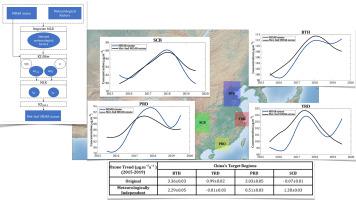Atmospheric Research ( IF 5.5 ) Pub Date : 2021-03-26 , DOI: 10.1016/j.atmosres.2021.105599 Seyedali Mousavinezhad , Yunsoo Choi , Arman Pouyaei , Masoud Ghahremanloo , Delaney L. Nelson

|
Despite the considerable reductions in primary and secondary air pollutants in China, surface ozone levels have increased in recent years. We report a trend of 3.3 ± 4.7 μg.m−3 year−1 in the annual mean maximum daily average ozone over an 8-h period (MDA8 ozone) across China between 2015 and 2019. Leveraging the Kolmogorov–Zurbenko filter method, we find that meteorology enhanced the ozone levels in Beijing–Tianjin–Hebei (BTH), the Yangtze River Delta (YRD), and the Pearl River Delta (PRD) while the reduction of solar radiation and the planetary boundary layer height accelerated ozone decreases in the Sichuan Basin (SCB) after 2017. Solar radiation and temperature increases, together with the reduction in sea level pressure, were the main contributors to enhance ozone in the YRD. They also contributed to 32% of ozone increases in BTH. Weaker meridional wind, lower relative humidity, and higher temperature escalated ozone enhancement in the PRD between 2016 and 2018. Regarding precursor emissions, NO2 long-term components showed a noticeable decline in all regions after 2017, partially due to the introduction of the most current action plan to reduce air pollutants over China in 2018. In contrast, the satellite-retrieved data suggest that VOC concentrations did not change substantially in target regions during the study period. After 2017, however, VOCs slightly increased in BTH, the YRD, and the PRD, which might be driven by temperature enhancements. Overall, the impact of meteorology on ozone variations was dominant in the YRD, the PRD, and the SCB from 2015 to 2019. Precursor emissions, however, played a leading role in ozone enhancement over the BTH. We also found that BTH and the YRD were in a transitional ozone formation regime while the PRD and the SCB tended to be more NOx-sensitive.


























 京公网安备 11010802027423号
京公网安备 11010802027423号